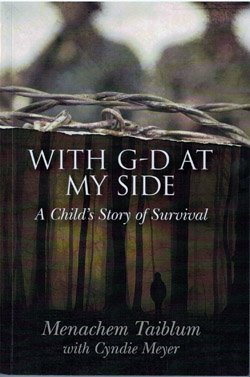With G-d At My Side: A Child’s Story of Survival by Menachem Taiblum (with Cyndie Meyer), CreateSpace © 2014; ISBN 978-150-586-2270; 150 pages.
By Donald H. Harrison

 SAN DIEGO – Cantor Menachem Taiblum of Portland, Oregon, recalls his boyhood running from the Nazis in this episodic memoir, which, with the help of writer Cyndie Meyer, has the page-turning flavor of an adventure story. It’s easy to read, and you can’t help but admire Taiblum for his bravery and determination.
SAN DIEGO – Cantor Menachem Taiblum of Portland, Oregon, recalls his boyhood running from the Nazis in this episodic memoir, which, with the help of writer Cyndie Meyer, has the page-turning flavor of an adventure story. It’s easy to read, and you can’t help but admire Taiblum for his bravery and determination.
He tells of growing up in an affluent Jewish home in Warsaw, being moved into a ghetto, and, under the pressure of starvation, escaping the ghetto one day to try to acquire food from a farmer acquaintance. Successful, the 12-year-old boy snuck back into the ghetto, to find that every member of his family, in fact every family on the whole black, had disappeared, victims of a Nazi roundup. He found one disoriented old man wandering around, and to him, he gave the food intended for his family. He snuck back out of the ghetto and returned to the home of the kind farmer.
Knowing it was not safe for either of them if Menachem stayed with him, the farmer arranged for Menachem to stay somewhere else and started him on a journey in which Menachem would acquire false ID papers as well as a good working knowledge of the Catholic religion, enabling him to pray as fervently as any Polish Catholic, whether in their homes or in their churches, and thereby escape detection as a Jew.
He kept on the move, but at one point he was caught up in a draft of Poles for a Nazi work camp. The farmer he was staying with had the option of sending someone in his stead, and so sent Menachem, now masquerading as Marian Redlicki.
At the camp, he witnessed some horrible brutality – a prisoner being whipped to death, a baby taken from a mother’s arms and tossed in the air for a Nazi officer’s target practice—but he also made a friend, a boy named Olek, one year older than he. One night, utilizing rubber pliers given to them by a nun to widen a path through the electrified fence, they made their escape from the work camp, and eventually made their way back to Warsaw, in time for the uprising, in which the two boys participated before escaping from Warsaw again, this time to find the Partisans in the forests.
Taiblum tells of learning how to place dynamite beneath railroad tracks, and describes his life among the partisans prior to the news reaching them that the war was over, that the Nazis had surrendered. Thereafter, we learn of Taiblum’s searching in vain for living relatives, and his migration to Israel, then to Brazil, and finally to the United States.
Well-written, it is for the most part, a boy’s-eye view of a monstrous epoch in world history.
*
Harrison is editor of San Diego Jewish World. Your comment may be sent to donald.harrison@sdjewishworld.com or posted on this website, per the instructions below.
__________________________________________________________________
Care to comment? San Diego Jewish World is intended as a forum for the entire Jewish community, whatever your political leanings. Letters may be posted below provided they are responsive to the article that prompted them, and civil in their tone. Ad hominem attacks against any religion, country, gender, race, sexual orientation, or physical disability will not be considered for publication. Letters must be signed with your first and last name, and you must state your city and state of residence. There is a limit of one letter per writer on any given day.
__________________________________________________________________